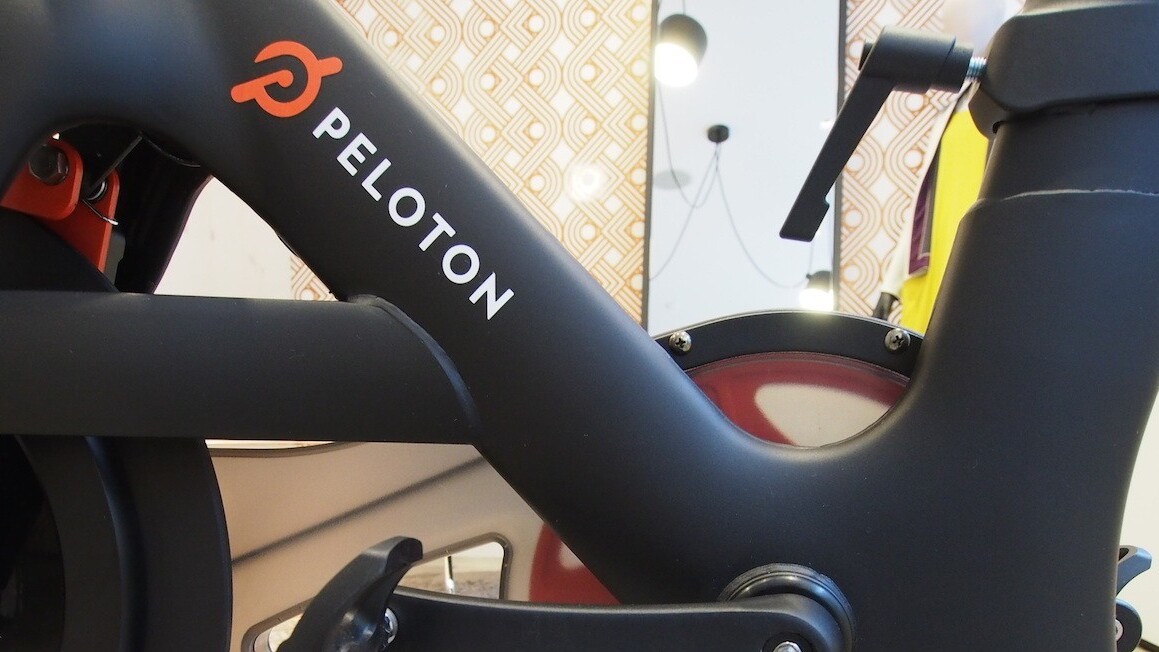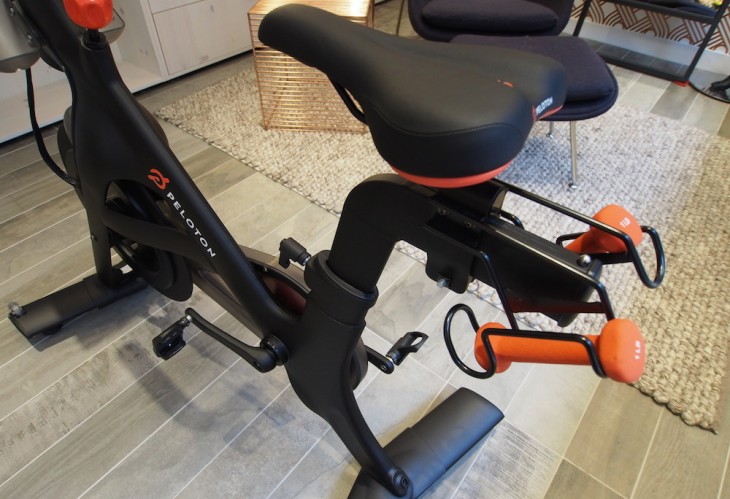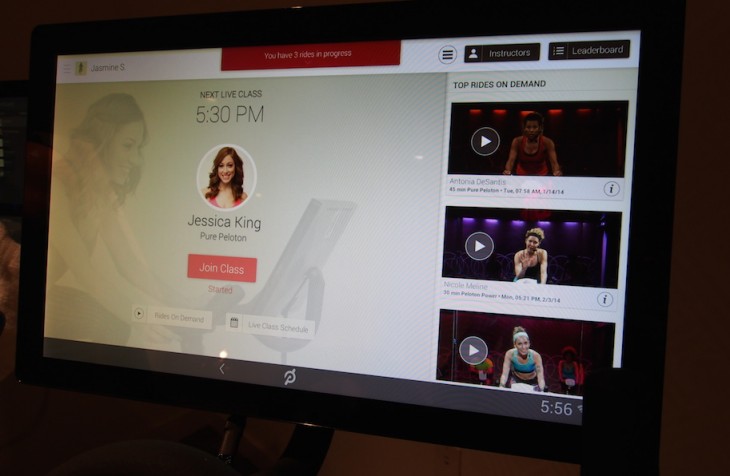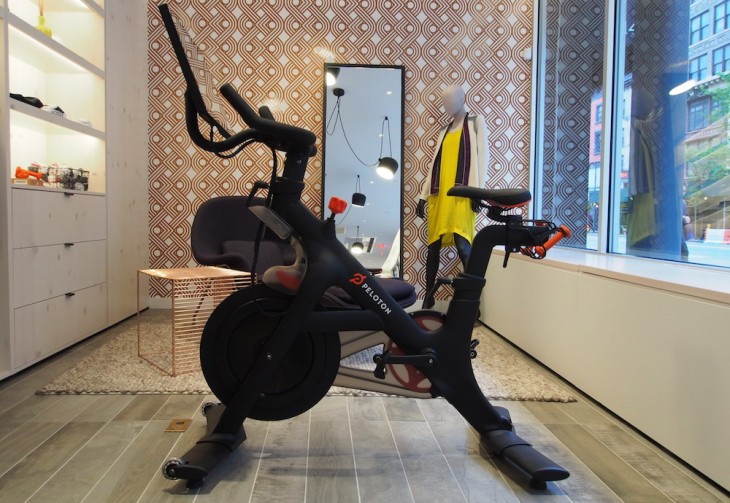
People make a lot of excuses not to exercise regularly. “I hurt my knee running the other day,” “I don’t have enough time,” “I hate going to the gym.” If you’ve ever uttered any iteration of the aforementioned phrases, Peloton Cycle wants to help.
Peloton is an indoor cycling bike that is equipped with Wi-Fi and a HD touchscreen display so you can stream live classes or access them on-demand. Co-founded by John Foley, formerly Barnes & Noble, Evite, and CitySearch, Peloton raised more than $300,000 on Kickstarter last year in its attempt to bring the spinning craze into your home.
For those who aren’t familiar with spinning, the workout is essentially indoor cycling with a trainer. The instructors help guide the class through exercise phases, such as sprints and hills. Spinning classes at boutique studios often come equipped with various music and light settings to keep the atmosphere fun and energized, motivating you to a full workout.
The difference between Peloton and traditional spinning bikes, Foley says, is Peloton’s ability to provide users with fresh content daily, keeping them engaged without leaving the comfort of their home. Access to live-classes from your own bike also means you never have to reserve a bike or show up early to guarantee a spot at a studio.
Peloton opened its New York flagship studio this spring, and we gave the bikes a ride to see if it could convert this excuse-making blogger into a fitness believer.
The Peloton bike
If you’ve followed Peloton from its Kickstarter days, you’ll see how the features touted in its pitch came to life. The bike boasts a belt drive rather than chains, keeping noise levels ultra low. The 21.5-inch HD screen is sweat-resistant, so you can select and pause the program even if your fingers are wet. It also comes with Bluetooth and ANT+ radio capacity to connect other accessories, such as wireless headphones or heart rate monitors. If you want to work out with friends in remote locations, the webcam can reveal your sweaty face to the world.

As with most exercise bikes, the seat height is adjustable, and the resistance knob is found in the middle within arm’s reach. There are also cleat locks to keep your spinning shoes connected to the bike, allowing for a smoother ride.
For those who cannot make it to the Peloton studios, the purchase of the Peloton comes with a white glove setup service. All you have to do is plug the bike in, connect to Wi-Fi, and make an online account to start biking and tracking your progress.
Classes on-demand
Just like you would search for a YouTube clip or a Netflix show, the Peloton interface lets you select classes depending on various search categories. You can sort classes by instructor, language, level and date, or choose to join in on a live class currently taking place at one of the Peloton studios.
On your Peloton screen are several metrics: Distance, Cadence, Output, Resistance and Calories. There’s also a leaderboard to pit your profile’s performance against other spinners who are either currently taking or have taken the class, and a timer to indicate how many minutes are left in the session. Each of these widgets can be tapped and hidden away if you want to focus on the instructor.
From our experience with the on-demand class, we found that the HD quality is quite stunning. You can literally see the sweat coming off the instructor as she yells at you to turn up the resistance. Foley says a new camera upgrade in the studios will bring even better quality videos to Peloton bikes worldwide.
If you can’t join the class live, the recording will be stored in the cloud so you can access a session from your preferred instructor. This also aids those in foreign countries who can’t make it for an eastern time class, or need classes in different languages.
At the moment, Peloton offers classes in English and Spanish, but it will bring on more instructors in various languages so users can access a variety of classes that best suit their needs.

How does it feel?
As a spinning newbie and an overall non-exerciser, I can tell you that the first 15 minutes suck. This seems to be why most people stop exercising regularly – because they can’t get over the hurdle from the initial pains. But if you’re a regular spinner, this should come easy and the virtual instructor yelling at you from afar does a good job at keeping you engaged.
For the particular class I took, my instructor would constantly advise us to change up the resistance every few minutes, or lift off the bike chair and dip our arms from side to side. This made time fly by faster, and her instructions to spin to the rhythm of the music in the background kept me in the right beat.
Although the first 15 minutes were hard to get through, after getting accustomed to the bike, it was hard not to continue. Most classes are 45 minutes long, and despite my legs giving in, I pedaled through the session. Besides, detaching the cleats to hop off the bike is an effort in itself.
The good thing about on-demand classes is that if you find that you don’t like your instructor, you can switch off and try a new one. You can’t do this with a live spinning class – once you’ve signed up, you’re stuck for that hour. Peloton also offers users a way to provide feedback directly to the specific instructor so they can learn about their students’ needs.
While the screen is indeed sweat-resistant, you must remember that it’s a touchscreen on an exercise bike, not the latest Android tablet. Responsiveness is not as fast as we’re used to seeing in traditional tablets and smartphones, but they work fine for what they’re intended for – especially when you’re wobbling side to side to keep balance on the bike.
Is it worth it?
I’ve heard about the benefits of endorphins that come from exercising, but the effects post-Peloton was frighteningly astonishing. After I left the studio, I felt pumped and energized, and was in an unusually chipper mood despite having just sweated my butt off. Unfortunately, this unexpected euphoria also kept me awake until 3 a.m. the next morning.
Without a doubt, Peloton Cycle is a luxury experience. At $1,995 a bike with a $39 monthly subscription, the cost is no replacement for your gym memberships and exercise machines (though admittedly, a stationary bike with a virtual screen can run you several thousand dollars more).
What this cost structure does give you is flexibility to exercise at your own time and place, without physical anxieties gyms can give you. The experience is surprisingly engaging for a virtual screen, and with Peloton opening studios in Chicago and Boston in the upcoming months, more content will be available at the tip of your fingers.
However, if you’re disciplined enough to search, find YouTube classes and work from your own traditional spinning bike in front of a TV or laptop, by all means save yourself the big bucks and use what works best for you physically and financially. As with most tech gadgets, you don’t need the device, but they sure are great to have.
Exercise is a difficult thing to judge because each person’s body react differently to various activities. If you are in the New York area, you can try Peloton at a pay-per-class rate of $30 (packages of multiple classes enjoy economy of scale).
The Peloton bike is available today worldwide.
Get the TNW newsletter
Get the most important tech news in your inbox each week.







